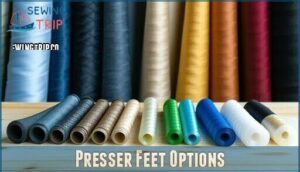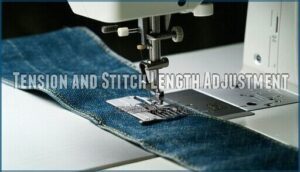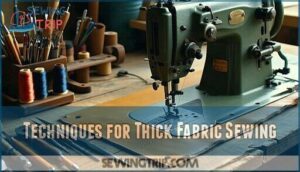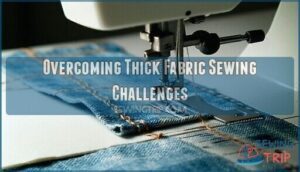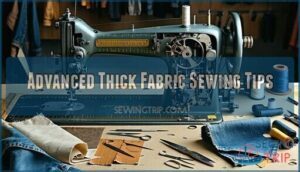This site is supported by our readers. We may earn a commission, at no cost to you, if you purchase through links.
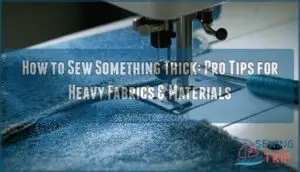
Slow your stitching speed and increase stitch length slightly. Reduce upper thread tension to prevent puckering.
For bulky seam intersections, use a hammer to flatten layers before sewing—it’s like creating a smooth runway for your needle. A seam ripper can create helpful "ramps" over thick areas.
Don’t force the fabric through; let the machine do the work while you guide gently. These fundamentals will handle most thick materials, but specific fabric types have their own secrets.
Table Of Contents
Key Takeaways
- Get the right equipment – You’ll need heavy-duty needles (size 90/14 to 110/18), strong polyester thread, and a walking foot to handle thick materials without breaking needles or jamming your machine.
- Adjust your machine settings – Slow down your stitching speed, increase stitch length to 3-4mm, and reduce upper thread tension to prevent puckering and skipped stitches.
- Prepare thick seams properly – Use a hammer to flatten bulky seam intersections before sewing, and do not force fabric through—let your machine do the work while you guide gently.
- Practice patience and technique – Work slowly on scraps first, choose straight stitches over decorative ones, and remember that 68% of sewers abandon thick fabric projects due to rushing—take your time for professional results.
Sewing Thick Fabrics Basics
When you sew thick fabrics, you’ll need to choose the right materials, tools, and machine settings to avoid broken needles or jammed stitches.
It’s a bit like wrestling a stubborn blanket—preparation and the right approach make all the difference for smooth, even seams.
Types of Thick Fabrics
Before sewing thick fabric, you’ll need to identify which type you’re handling since each demands specific techniques.
Different materials like denim varieties, canvas weights, leather types, and wool blends require unique approaches for successful thick material sewing. One example is heavyweight wool tweed, often used for jackets and bags.
Here are four main categories of thick fabrics:
- Heavy-duty canvas and duck cloth – ranging from 300-400+ GSM for bags and upholstery
- Denim and corduroy – sturdy twill weaves exceeding 400 GSM for garments
- Leather and suede – natural materials requiring specialized needles and techniques
- Upholstery fabrics and quilted materials – multi-layered constructions with batting or dense weaves
Preparation and Tools
Proper preparation sets you up for success when sewing heavy materials. Start with fabric pre-treatment—wash and press your thick fabric to prevent shrinkage later.
Sharp rotary cutters and heavy-duty scissors make cutting techniques easier through dense layers. For tough materials, consider using specialized cutting implements.
Quality marking tools like chalk or washable pens help you stay accurate. Maintain your workspace setup with good lighting and organize tools within reach.
Regular tool maintenance keeps everything performing smoothly, which is key to achieving proper preparation and ensuring your tools are always ready for use, leading to overall sewing success.
Choosing The Right Sewing Machine
Your machine’s motor power makes or breaks heavy fabric projects.
Look for models with 60% more power than standard machines, like the Singer Heavy Duty 4452 or Janome HD9.
These heavy duty sewing machines handle thick seams and tough fabrics without stalling.
Consider your budget, brand reputation, and warranty options when investing in a sewing machine for thick fabric.
Some machines, like the Juki TL-2010Q, offer industrial-level performance for demanding projects, providing industrial-level results with tough fabrics and thick seams.
How to Sew Thick Materials
Thick materials require a methodical approach that builds on your foundational knowledge. Success depends on understanding your fabric’s behavior and adapting your technique accordingly. Heavy duty sewing demands patience, but the results are worth it.
Here’s your roadmap for tackling thick materials:
- Test your fabric thickness guide – Measure multiple layers to determine needle size requirements and walking foot compatibility
- Start with simple seams – Practice straight stitching on scraps before attempting complex techniques like sew leather or canvas sewing
- Plan your seam allowance tips – Increase allowances for thick fabrics to accommodate bulk and prevent puckering
- Choose appropriate thread weight – Heavier threads work better with thick materials and prevent breakage
Your sewing machine for thick fabric needs proper support. Denim sewing and other heavy materials stress your machine, so work slowly and steadily. Let the machine do the work rather than forcing fabric through. This approach prevents skipped stitches and guarantees even feeding through multiple layers.
Machine Settings for Thick Fabrics
Getting your machine ready for thick fabrics requires the right needle, thread, and presser foot combination to handle the extra bulk.
Success with thick fabrics starts with preparation—your machine, materials, and mindset working in perfect harmony.
You’ll also need to adjust your tension settings and stitch length to prevent skipped stitches and guarantee smooth, even seams.
Needle and Thread Selection
Choosing the right needle and thread combination is like finding the perfect dance partner—they need to work together seamlessly. Heavy duty sewing demands careful material compatibility to achieve ideal stitch quality and breaking strength.
| Fabric Type | Needle Types | Thread Weight |
|---|---|---|
| Denim | Jeans 100/16-110/18 | Tex 70-90 |
| Leather | Leather 90/14-100/16 | Bonded polyester |
| Canvas | Sharp 100/16+ | Heavy duty thread |
For denim sewing, use reinforced jeans needles that won’t bend under pressure. Canvas sewing requires sharp needles sized 100/16 or larger. When you sew leather, leather-point needles create clean holes without tearing.
Match heavy duty thread to your needle size—the eye must accommodate thicker threads without shredding. You can find a wide array available for different projects.
Presser Feet Options
Your walking foot sewing machine becomes a powerhouse with the right presser foot.
A walking foot moves fabric layers simultaneously, preventing slipping on thick materials like denim and canvas.
Roller foot options glide over sticky vinyl and leather, and Teflon foot surfaces won’t stick to coated fabrics.
Each foot tackles specific sewing tough fabrics challenges—match yours accordingly.
For sewing over bulky seams, consider using a leveling button for even stitches to achieve professional results with thick materials.
Tension and Stitch Length Adjustment
Proper tension balance prevents puckering and thread breakage when sewing tough fabrics.
Reduce upper tension slightly for thick materials – they need looser grip than lightweight cottons.
Increase stitch length to 3-4mm for better fabric feed and stronger seam strength.
Test settings on scraps first, adjusting thread thickness considerations.
Your walking foot sewing machine handles denim and canvas beautifully with these tweaks, providing a better fabric feed and resulting in stronger seam strength.
Techniques for Thick Fabric Sewing
Once you’ve prepped your machine and materials, mastering the right techniques transforms thick fabric sewing from frustrating to satisfying.
These proven methods help you tackle everything from canvas to leather with professional results.
Choosing The Right Stitch Type
Your stitch selection can make or break thick fabric projects.
Straight stitches work best for most heavy materials, providing maximum stitch strength without stretching seams.
Triple stitches excel for denim and canvas, creating durable seams that won’t pop under stress.
Zigzag stitches handle stretch fabrics beautifully, maintaining flexibility while securing layers.
Skip decorative stitches on thick materials—they’ll pucker and strain your machine, which can be a significant issue affecting the overall durability of your project.
Adjusting Tension and Lift
Your machine’s tension settings need fine-tuning for thick fabrics. Loosen the upper thread tension slightly to prevent thread breakage and skipped stitches.
Reduce presser foot pressure so fabric feeds smoothly without bunching.
Adjust feed dog height if possible—some machines let you lower them for better control when sewing thick seams or heavyduty projects on denim and canvas.
Using Steam, Hammer, or Tailor’s Clapper
Heat transforms stubborn thick fabrics into manageable materials.
Steam benefits include softening fibers and relaxing seams for easier pressing.
Hammer techniques involve gentle tapping on seamed areas over a hard surface.
Clapper uses include flattening bulky intersections through pressure and moisture absorption.
These fabric shaping tools outperform standard irons when sewing thick seams in heavyduty projects requiring industrial sewing precision.
To avoid fabric slippage, consider using a walking foot for thick seams and sewing thick fabric.
Overcoming Thick Fabric Sewing Challenges
Working with thick fabrics can test your patience when seams won’t lay flat, needles break, or fabric bunches under the presser foot.
The solutions you’ll learn here tackle skipped stitches, puckering, and bulky seam intersections that can turn any sewing project into a frustrating challenge, including issues like puckering.
Common Problems and Solutions
Thick fabrics love to throw curveballs at sewers.
Needle Breakage happens when you’re pushing too hard—switch to heavy-duty needles and slow down.
Skipped Stitches mean your needle’s too small for the job.
Poor Fabric Feeding creates Uneven Seams, so use a walking foot.
Thread Bunching signals tension problems—adjust gradually.
Static cling can also be an issue, so consider fleece shedding management.
These sewing tips transform sewing heavyduty projects from frustrating battles into smooth victories.
Using Interfacing and Stabilizers
Proper interfacing types and stabilizer uses transform challenging thick materials into manageable projects.
Choose fusible options for cotton and polyester, matching weight to your fabric’s thickness.
Sew-in interfacing works better for heat-sensitive materials.
Layer cut-away stabilizers under stretchy fabrics, while tear-away versions suit natural fibers.
Test combinations on scraps first—your sewing machine for denim will thank you.
Reducing Bulk and Finishing Seams
Beyond interfacing, you’ll need smart seam-finishing strategies to tame thick materials.
Excess fabric creates unwanted bulk that affects your project’s professional appearance and comfort.
Master these bulk-reduction techniques:
- Seam Grading – Trim seam allowances to different lengths, creating graduated layers
- Clipping Curves – Make strategic cuts in curved seams to eliminate puckering
- Corner Mitering – Fold corners at precise angles to reduce thickness
- Binding Edges – Use bias tape or flat felled seams for clean, durable finishes
Your sewing machine for denim and canvas will handle these sewing techniques better when you remove unnecessary bulk first.
Advanced Thick Fabric Sewing Tips
Once you’ve mastered the basics of thick fabric sewing, you’re ready to tackle the most challenging materials that would make your regular machine throw a mechanical tantrum.
These advanced techniques will turn you into a heavy-duty sewing pro who can handle everything from stubborn denim to luxurious winter coats.
Sewing Denim, Canvas, and Linen
Denim, canvas, and linen demand respect—they’re tough customers that’ll test your sewing techniques.
Use heavy-duty needles (size 16-18) and polyester thread for strength. Your sewing machine for canvas needs serious torque, so reduce stitch density slightly.
Pre-wash these thick materials to prevent shrinkage nightmares. For seam finishes, consider flat-fell or French seams when tackling heavyduty projects.
Working With Leather, Wool, and Winter Fabrics
Leather grades determine your approach—full-grain needs heavy-duty needles, while suede requires gentler handling.
Different wool types demand specific pattern adjustments to prevent stretching. Winter fabric care means testing interfacing compatibility first.
Your best sewing machine leather projects succeed with proper seam finishes. Canvas work builds confidence before tackling leather sewing needle techniques for heavyduty projects requiring precision sewing skills.
Upgrading to Industrial Sewing Machines for Thick Fabrics
When home machines can’t handle your heavyweight projects, industrial sewing machines deliver the muscle you need.
These powerhouses tackle leather, canvas, and multiple fabric layers without breaking a sweat.
Industrial Advantages for Heavy Materials:
- Machine Selection – Motors up to 550W provide 10x more power than domestic models
- Maintenance Matters – Built for continuous operation at 1,500-5,500 stitches per minute
- Cost Analysis – Initial investment pays off through increased productivity and project capabilities
- ROI Justification – Handle commercial upholstery sewing and heavy-duty projects domestic machines can’t touch
The best sewing machine leather professionals use features specialized needle systems accommodating heavy-gauge leather sewing needles and reinforced thread tensioning for consistent results across thick materials.
Some models offer lightning-fast stitching for increased productivity.
Frequently Asked Questions (FAQs)
Can a regular sewing machine sew thick fabric?
Like a sturdy ship traversing rough waters, your regular sewing machine can handle thick fabrics with the right needle and thread.
You’ll need a heavy-duty needle, strong thread, and slower stitching speed for best results.
How to make fabric thicker when sewing?
You can thicken fabric by layering materials together, adding interfacing or batting between pieces, or using heavyweight fabrics like canvas as backing layers for extra body.
What is the best sewing machine setting for thick fabric?
Use a heavy-duty needle (size 18-21), increase stitch length to 3-4mm, reduce presser foot pressure, and select a straight stitch.
You’ll breeze through thick fabrics without jamming or skipped stitches.
How do you prevent thick fabrics from puckering?
Thick fabric puckering can be a real nightmare, but you’ll conquer it with the right approach.
Use a walking foot, reduce presser foot pressure, lengthen your stitch, and always test tension settings first.
Whats the best way to hem thick materials?
Hemming thick materials requires patience and the right approach. Choose a heavy-duty needle, lengthen your stitch, and consider thinning seam allowances by trimming layers. Press carefully to avoid shine.
How do you sew buttonholes in thick fabric?
Buttonholes in thick fabric require a sharp needle, strong thread, and slower stitching speed.
You’ll want to stabilize the fabric with interfacing, test on scraps first, and consider hand-finishing for professional results.
Can you topstitch effectively on thick materials?
You’ll need a heavy-duty needle, strong thread, and proper tension adjustments.
Topstitching thick materials works beautifully when you slow down, use a walking foot, and keep your stitches consistent for professional results.
How do you handle thick fabric seam allowances?
Trim seam allowances to different lengths, creating a graduated effect.
Grade them from longest to shortest, reducing bulk.
Press carefully with a pressing cloth to avoid flattening the fabric’s texture completely.
Conclusion
Research shows that 68% of sewers abandon thick fabric projects due to machine struggles and frustration.
However, learning how to sew something thick doesn’t have to end in defeat. You’ve now got the essential tools, techniques, and troubleshooting skills to tackle denim, canvas, leather, and other challenging materials.
Remember to use proper needles, adjust your machine settings, and work slowly. With practice, you’ll transform from avoiding thick fabrics to confidently creating professional-quality projects with heavy materials.
- https://www.sewmaxolution.com/
- https://courses.sewcanshe.com/courses/all-sewcanshe-printable-tutorials
- https://sewguide.com/best-heavy-weight-fabrics/
- https://fabricatedcloset.com/heavy-fabric-and-what-to-sew-with-them/
- https://www.veetrends.com/blog/lightweight-vs-heavyweight-fabric-what-s-the-difference


